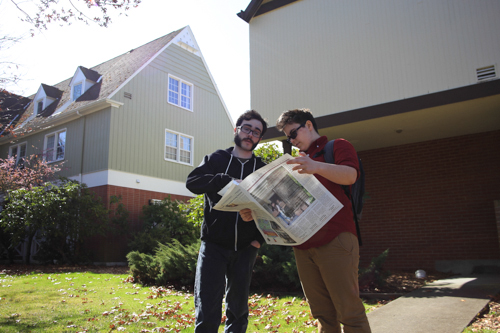Technological demands have increased at an astronomical rate over the past few years, and the Technology Services department is struggling to keep up. The demand for bandwidth has led to campus-wide internet issues for students and staff alike.
The latest statistics from Technology Services indicate that each student on campus carries, on average, more than four devices that utilize the campus’s internet. This equates to over 10,000 electronic devices, wired and wireless, demanding online access. To accommodate this need, Puget Sound has had to use financial and technological resources more than ever.
“We’re trying to get ahead of this,” Deputy CIO Travis Nation said. “We’re doing these emergency repairs to get [better] wireless in the residence halls and in key areas.”
The problem doesn’t just start with the number of devices. “It’s also what’s happening on those devices that’s putting a lot of strain on how much bandwidth we have and whether or not people are getting the kind of service they expect,” Technology Services Communications Manager M.K. Smith said.
Streaming video, downloads, and online gaming experiences can all contribute to the heavy burdens on the bandwidth. With the large number of students accessing the internet at the same time, the network struggles to support the sheer amount of activity at Puget Sound.
One of the problems is caused by students bringing in their own Wireless Access Points (AP) to get better service in their residence halls. However, the frequency at which the student APs broadcast is the same as the frequency of the university’s APs.
When the network-installed wireless signal sees the new AP, the net signal strength is reduced for individual students on the internet. “That shuts off the network for a lot of the students,” Chief Information Officer William Morse said. Morse went on to say that one hall had over 60 student-run APs, which crippled the internet strength for every resident.
Technology Services plans to bring in software to combat this issue, turning off ‘rogue’ APs. In the meantime, however, Puget Sound students with personal APs are highly encouraged to shut them down for the sake of everyone’s browsing experience.
In public areas and in some residence halls, there is an issue with older APs (g-wireless) – not being able to handle the large amount of traffic brought in by the influx of devices.
Most of the buildings and the residence halls are running the fastest versions available (ac-wireless), but the Technology Services department still needs to send in workers
to manually exchange the slow APs.
Despite these problems and the slower progress that goes into repairing the internet connections for students and staff all over campus, there are filters in place to ensure that the maximum bandwidth is available for people connected to the internet.
“We’re looking at what our options are,” Morse said. “We already addressed some residence halls…we’re mapping where our weaknesses are.” Over time, the density of APs is expected to increase and allow for more power at more places. However, this advancement does require rewiring and many other of the department’s resources, including additional routers.
The main goal of the department is to finish upgrading all g-wireless points to ac-wireless points. Even some of the administrative buildings are still crippled by g-wireless points.
“Not only are the new devices faster, but they can also handle more devices per unit,” Nation said. “It allows us to put the same number of APs out there, while hitting more of those devices.”
By mapping out the areas of campus with the most wireless density, Technology Services is able to detect where additional APs are still needed. Areas with more congestion such as Diversions and the library might require that signal boost to satisfy student and staff needs.
Even in areas such as Marshall Hall, where renovations are taking place, there has been an initiative to plant temporary APs for internet users.
“When the remodel is complete, we’ve spec’d it out with the new standards,” Nation said.
“We’re coming up with a strategy for long-term. It’s going to take us some time to hit all the areas, but it is something we’re aware of, and it’s helpful to get the student feedback,” Nation said.
The Technology Services website frequently updates with announcements about the university’s network and how it is changing to best suit the needs of students and staff.
Open and detailed communication with the technology department is encouraged to maintain a smooth connection between everyone logged in to the Puget Sound community.



